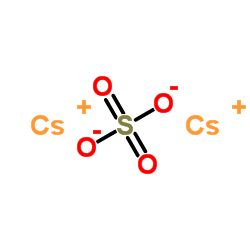Dicaesium sulfate

Dicaesium sulfate structure
|
Common Name | Dicaesium sulfate | ||
|---|---|---|---|---|
| CAS Number | 10294-54-9 | Molecular Weight | 361.874 | |
| Density | 4.243 g/mL at 25 °C(lit.) | Boiling Point | 1900 °C | |
| Molecular Formula | Cs2O4S | Melting Point | 1019 °C(lit.) | |
| MSDS | Chinese USA | Flash Point | STABILITY | |
|
Action of neuropeptide Y on nociceptive transmission in substantia gelatinosa of the adult rat spinal dorsal horn.
Neuroscience 134(2) , 595-604, (2005) Effects of neuropeptide Y (NPY) on substantia gelatinosa neurons were investigated in adult rat spinal cord slices using blind whole-cell patch-clamp technique. Bath application of NPY (1 microM) induced a membrane hyperpolarization, resulting in a suppressio... |
|
|
Density gradient analysis of secretions produced in vitro by human and canine airway mucosa: identification of lipids and proteoglycans in such secretions.
Exp. Lung Res. 10(4) , 401-22, (1986) Human and canine airway mucosal explants synthesize and secrete high molecular weight glycoconjugates, incorporating 14C-glucosamine, a radioactive precursor to epithelial glycoprotein. Our examination of secretions produced by several individual specimens, h... |
|
|
Biochemical characterization of a cellular structure retaining vegetally localized RNAs in Xenopus late stage oocytes.
J. Cell. Biochem. 80(4) , 560-70, (2001) Two pathways operate during Xenopus oogenesis to localize a small number of RNAs to the vegetal cortex. Correct localization of these RNAs is essential to normal development as the proteins they encode are involved in specifying cell type and in patterning th... |
|
|
An automated method for determining buoyant density of nucleic acids using a preparative ultracentrifuge.
Anal. Biochem. 159(1) , 88-95, (1986) We present a technique for analytical buoyant density sedimentation of nucleic acids which is performed in a preparative ultracentrifuge, in contrast to an analytical ultracentrifuge. Following centrifugation in a preparative rotor, small cylindrical quartz t... |
|
|
Flow-injection chemiluminometric determination of some thioxanthene derivatives in pharmaceutical formulations and biological fluids using the [Ru(dipy)3(2+)]-Ce(IV) system.
Anal. Sci. 17(11) , 1257-61, (2001) A flow-injection (FI) methodology using tris(2,2'-dipyridyl)ruthenium(II), [Ru(dipy)3(2+)], chemiluminescence (CL) was developed for the rapid and sensitive determination of three thioxanthene derivatives, namely zuclopenthixol hydrochloride, flupentixol hydr... |
|
|
Salt effects on the denaturation of DNA.
Biopolymers 7(4) , 557-70, (1969) When DNA's of differing GC:AT base ratios, e.g. synthetic poly dAT, T4 DNA,calf thymus DNA, E. coli DNA, and M. lysodeikticus DNA, are heat-denatured at neutral pH in increasing concentrations of N(a)(2)SO(4) or C(s)(2)SO(4) as supporting electrolytes,the var... |
|
|
Proteoglycan complex and proteoglycan subunit polydispersity. Study by isopycnic centrifugation in cesium sulfate density gradients.
Biochim. Biophys. Acta 623 , 57, (1980) A true isopycnic centrifugation method for the study of the bovine nasal cartilage proteoglycan polydispersity is presented. The use of cesium sulfate as gradient forming salt instead of cesium chloride allowed proteoglycan banding without any sedimentation a... |
|
|
The use of caesium sulphate density gradient centrifugation to analyse proteoglycans from human articular cartilages of different ages.
Biochim. Biophys. Acta 759(1-2) , 58-66, (1983) Proteoglycan subunits from human articular cartilage were fractionated by caesium sulphate density gradient centrifugation. A single heterogeneous population of molecules was produced whose average density decreased with increasing age of the individual from ... |
|
|
Soaking in Cs2SO4 reveals a caesium-aromatic interaction in bovine-liver rhodanese.
Eur. J. Biochem. 177(2) , 345-9, (1988) Soaking crystals of rhodanese (thiosulphate:cyanide sulphurtransferase) in 2 M caesium sulphate reveals three caesium binding sites of this enzyme. One of these had been described before as a binding site for sodium ions and is located in a cleft close to the... |
|
|
Cs(+) causes a voltage-dependent block of inward K currents in resting skeletal muscle fibres.
Nature 267(5607) , 169-70, (1977) When frog skeletal muscle fibres are bathed in solutions containing Cs(+) and K(+) in the ratio 1:4,000, a reduction is observed in the size of inward K currents through the resting membrane. This effect is enhanced by an increase in either hyperpolarisation ... |